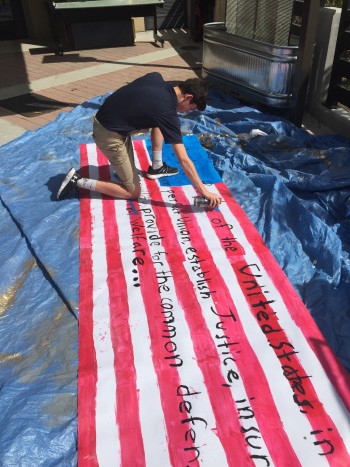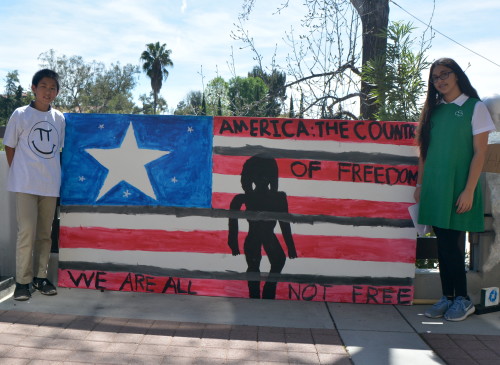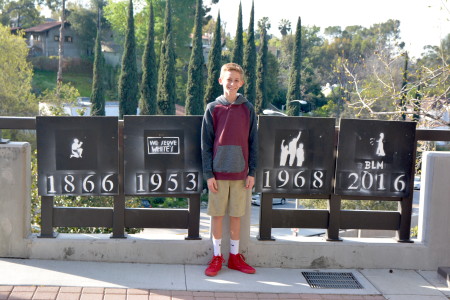In May, Maker Ed had the privilege of curating the Education stage at the Bay Area Maker Faire in San Mateo. Every educator and youth who took the stage during the Faire brought with them inspiring stories and examples of how making is positively impacting the lives of young learners. One standout example comes from Nathan Mook, the Social Studies Department Chair and a 7th-grade classroom teacher at Chandler School, a K-8 coeducational independent school Pasadena, California. He is using street art as a vehicle for students to explore and understand important issues facing their generation. Below, Nathan shares his story of how and why he developed the program, and reflects on why presenting at the Maker Faire is such a valuable experience.
Author: Nathan Mook

I was first introduced to the Maker Movement five years ago by a fellow teacher. I immediately saw the value and importance of implementing making in our schools, but I was unsure how to add it into my Social Studies curriculum. Shortly thereafter, I moved to Los Angeles and immediately fell in love with how the city allowed artists to beautify buildings with street art. All of a sudden, it became clear to me the way in which making would find its way into my classroom. I believe the beauty of making is its ability to empower students to share their voices in an artistic and innovative fashion, and making street art is a powerful experience. It gives artists a unique platform to reach the general public and seemed like a perfect way to introduce making to my students and to help them share their voices through a new medium and in new ways.
 The Street Art Project is a component of my students annual Capstone Project. Each year, students pick from ten pressing global issues that affect their generation. Examples from this year include; self-driving cars, alternative energy, Syrian Refugee Crisis and social justice movements. After choosing a topic of personal interest, students begin curating sources and collecting research. Students are asked to analyze each source carefully and to consider the many viewpoints from which the topic could be considered. Eventually, students are asked to examine their own bias, choose a point of view, and present an opinion about their topic. Students then ideated, designed and built a work of street art to represent what they’ve thought and learned. They have the opportunity to work paint, cardboard, plastic, plaster, wood and power tools to create an attention-grabbing work of art that would make passersby stop, think, and question their own opinions on a global issue. The student projects take on a variety of forms ranging from murals, to prototypes, to pop-up displays. Every year, students bring new ideas to the project and create a variety of engaging products. A few examples include building a model energy efficient city that runs on solar power to show the benefit of alternative energy initiatives and building a refugee tent to display the conditions of millions of Syrian refugees. These projects are then installed throughout the campus for several weeks for the community to see and ask questions about the message behind each installment.
The Street Art Project is a component of my students annual Capstone Project. Each year, students pick from ten pressing global issues that affect their generation. Examples from this year include; self-driving cars, alternative energy, Syrian Refugee Crisis and social justice movements. After choosing a topic of personal interest, students begin curating sources and collecting research. Students are asked to analyze each source carefully and to consider the many viewpoints from which the topic could be considered. Eventually, students are asked to examine their own bias, choose a point of view, and present an opinion about their topic. Students then ideated, designed and built a work of street art to represent what they’ve thought and learned. They have the opportunity to work paint, cardboard, plastic, plaster, wood and power tools to create an attention-grabbing work of art that would make passersby stop, think, and question their own opinions on a global issue. The student projects take on a variety of forms ranging from murals, to prototypes, to pop-up displays. Every year, students bring new ideas to the project and create a variety of engaging products. A few examples include building a model energy efficient city that runs on solar power to show the benefit of alternative energy initiatives and building a refugee tent to display the conditions of millions of Syrian refugees. These projects are then installed throughout the campus for several weeks for the community to see and ask questions about the message behind each installment.
 I have found that street art gives students a voice to express how they feel about issues that they are studying, and ultimately helps them develop well-informed opinions about complex topics. Students are often motivated by the fact that their opinions will be visually displayed for the community to see for the duration of a few weeks. As an educator, I’ve seen the amazing things that can happen when students are given the opportunity to examine and explore their opinions, ideas, and passions in a self-driven way through making. In my classroom, the street art capstone project has provided this opportunity in an incredible way, and it was an amazing thrill to share what I’ve learned with other educators at this year’s Bay Area Maker Faire.
I have found that street art gives students a voice to express how they feel about issues that they are studying, and ultimately helps them develop well-informed opinions about complex topics. Students are often motivated by the fact that their opinions will be visually displayed for the community to see for the duration of a few weeks. As an educator, I’ve seen the amazing things that can happen when students are given the opportunity to examine and explore their opinions, ideas, and passions in a self-driven way through making. In my classroom, the street art capstone project has provided this opportunity in an incredible way, and it was an amazing thrill to share what I’ve learned with other educators at this year’s Bay Area Maker Faire.
How might you use street art, or other forms of public making, as a way to get your students thinking about critical issues facing their communities, and the wider world? Perhaps get your students’ minds working by exploring the UN Sustainable Development Goals as maker educator Gaelyn Jenkins did in her library at Riverside Middle School in Greenville, SC (learn more about Gaelyn’s work in this episode of Ask a Maker Educator).
Here are some additional resources to explore if you’d like to learn more about the community building power of street art:
- A video highlighting Nathan’s students’ work on the Chandler School Facebook page
- “Take a Walking Tour of the Mission’s Vibrant Street Art” by James Vest in 7×7
- Precita Eyes Muralists
- Mural Arts Philadelphia
Share your thoughts, inspirations and projects on social media using #MakerEd. Be sure to tag us @MakerEdOrg in your posts!

Leave a Reply